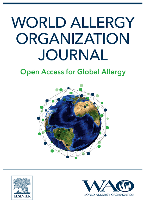
World Allergy Organization Journal
Scope & Guideline
Advancing the Science of Allergy and Immunology
Introduction
Aims and Scopes
- Research on Allergic Conditions and Diseases:
The journal publishes studies on a wide range of allergic disorders, including asthma, allergic rhinitis, food allergies, atopic dermatitis, and anaphylaxis, exploring their epidemiology, pathophysiology, and clinical management. - Innovative Therapeutic Approaches:
There is a strong emphasis on the exploration of new therapies, including biologics, immunotherapy, and novel pharmacological treatments, aimed at improving patient outcomes in allergic diseases. - Patient-Centered Care and Quality of Life:
The journal highlights research that evaluates the impact of allergic diseases on patient quality of life and emphasizes patient-centered management strategies. - Multidisciplinary Collaboration:
The journal encourages collaboration among various specialties, including allergists, immunologists, and primary care providers, to foster comprehensive care for patients with allergies. - Global Perspectives on Allergy:
The journal addresses global trends and disparities in allergy prevalence, management practices, and healthcare access, contributing to a broader understanding of allergy on an international scale.
Trending and Emerging
- Biologics and Targeted Therapies:
There is a growing emphasis on the efficacy and safety of biologics in treating severe allergic conditions, including asthma and chronic urticaria, reflecting advancements in targeted therapy and personalized medicine. - Impact of COVID-19 on Allergic Diseases:
Recent publications have increasingly addressed the implications of the COVID-19 pandemic on allergic diseases, including changes in symptom management, treatment adherence, and the effects of vaccination on allergic patients. - Microbiome and Allergic Disease Interactions:
Research exploring the relationship between the microbiome and allergic diseases is gaining traction, highlighting the complex interactions that may influence the development and management of allergies. - Patient-Centered Approaches and Quality of Life:
There is a noticeable trend towards prioritizing patient-reported outcomes and quality of life in allergy research, emphasizing the importance of aligning treatment strategies with patients' needs and experiences. - Genetic and Molecular Insights into Allergies:
Emerging studies are increasingly focusing on genetic predispositions and molecular mechanisms underlying allergic diseases, aiming to identify novel biomarkers and therapeutic targets.
Declining or Waning
- Traditional Allergy Testing Methods:
There has been a noticeable decline in studies focusing solely on traditional allergy testing methods such as skin prick tests, as newer, more advanced diagnostic techniques and biomarkers are gaining prominence. - Isolated Food Allergy Studies:
Research specifically focused on isolated food allergies without considering broader implications or comorbidities has diminished, indicating a shift towards more integrated studies that address multiple allergic conditions. - Environmental Allergens without Contextual Factors:
Papers focusing solely on environmental allergens, such as pollen counts or dust mites, without considering contextual factors like climate change or urbanization impacts have decreased, suggesting an evolution towards more comprehensive environmental studies.
Similar Journals
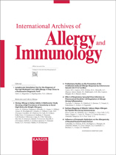
INTERNATIONAL ARCHIVES OF ALLERGY AND IMMUNOLOGY
Connecting Researchers and Clinicians in Allergy Science.INTERNATIONAL ARCHIVES OF ALLERGY AND IMMUNOLOGY, published by KARGER, is a distinguished journal dedicated to advancing the field of immunology and allergy research. With an ISSN of 1018-2438 and an E-ISSN of 1423-0097, this journal has been a vital resource since its inception in 1950, continuing to publish influential articles through 2024. Hailing from Switzerland, it holds an important position within the Q3 category in Immunology and Allergy and Q2 in miscellaneous Medicine, reflecting its growing impact in the scientific community. The Scopus rankings showcase its relevance, with a 52nd percentile in Immunology and Allergy and 45th in Immunology and Microbiology. Although not an open-access journal, it plays a critical role in disseminating significant findings and innovations in the understanding of allergic diseases and immunological responses. The INTERNATIONAL ARCHIVES OF ALLERGY AND IMMUNOLOGY is essential for researchers, clinicians, and students eager to stay at the forefront of allergy and immunology developments.

Current Allergy & Clinical Immunology
Empowering professionals with cutting-edge research.Current Allergy & Clinical Immunology is a vital peer-reviewed journal published by the Allergy Society of South Africa, focused on advancing the field of immunology and allergy medicine. With an ISSN of 1609-3607, this journal offers crucial insights and research findings pertinent to the understanding and treatment of allergic conditions. Operating from South Africa, it features contributions from a diverse range of authors and professionals in the field. Published from 2008 to 2024, the journal plays an essential role in disseminating current knowledge, even as it holds a Q4 ranking in Immunology and Allergy and is positioned at the 4th percentile based on Scopus rankings. While not open access, it remains an important resource for researchers, practitioners, and students looking to stay informed on emerging trends and breakthroughs in allergy and clinical immunology.
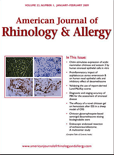
American Journal of Rhinology & Allergy
Championing breakthroughs in allergy and sinus disease.Welcome to the American Journal of Rhinology & Allergy, a leading publication in the fields of otolaryngology and immunology, published by SAGE Publications Inc. Since its inception in 2009, this journal has played a pivotal role in disseminating cutting-edge research and reviews, addressing critical topics related to sinus disease, allergic disorders, and respiratory health. With an impressive Scopus ranking that places it in the top quartiles of both immunology and medicine, the journal garners about a 90th percentile ranking in otorhinolaryngology, reflecting its significance in advancing medical knowledge and clinical practice. The American Journal of Rhinology & Allergy aims to bridge the gap between laboratory research and clinical application, providing a platform for researchers and professionals to explore innovative therapies and treatment protocols. Access options include traditional subscription models to ensure comprehensive support for the academic community. Join our efforts to enhance understanding and treatment in the critical area of rhinology and allergy.
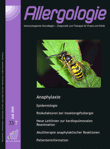
ALLERGOLOGIE
Fostering Innovation in Allergy ResearchALLERGOLOGIE is a prominent academic journal dedicated to the field of immunology and allergy, published by DUSTRI-VERLAG DR KARL FEISTLE in Germany. Since its inception in 1978, the journal has provided a vital platform for researchers, clinicians, and students to disseminate their findings, share insights, and foster advancements in the understanding of allergic diseases and immunological responses. With an ISSN of 0344-5062 and an E-ISSN of the same number, it is a respected source within its category, currently ranked in the 2023 Q4 of the Scopus metrics in immunology and allergy, reflecting its commitment to quality and scholarly rigor. Although not fully open access, ALLERGOLOGIE makes significant contributions to the dialogue on allergy-related topics, encouraging engagement from its readership through a diverse array of articles that span from clinical trials to innovative research methods. This journal continues to be an essential resource for anyone involved in the pursuit of knowledge in allergy and immunology.

Egyptian Journal of Pediatric Allergy and Immunology
Illuminating the path to improved outcomes in pediatric allergies.Welcome to the Egyptian Journal of Pediatric Allergy and Immunology, a leading academic platform dedicated to the advancement of knowledge in the field of pediatric allergy and immunology. Published by the prestigious Egyptian Society of Pediatric Allergy & Immunology, this journal aims to address the pressing challenges and breakthroughs in the diagnosis, treatment, and management of allergic diseases in children. As a crucial resource for researchers, healthcare professionals, and students, it focuses on disseminating high-quality, peer-reviewed articles that contribute to the global understanding of allergic conditions and immunological responses in pediatric populations. Although the journal is currently not an Open Access publication, it provides a valuable gateway to research findings that can shape clinical practice and influence future investigations. With an emphasis on contributing to improved healthcare outcomes for children suffering from allergy and immunology disorders, the Egyptian Journal of Pediatric Allergy and Immunology stands out as an essential reference in the field.
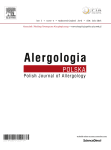
Alergologia Polska-Polish Journal of Allergology
Advancing allergy research for a healthier tomorrow.Alergologia Polska - Polish Journal of Allergology, published by TERMEDIA PUBLISHING HOUSE LTD, is a distinguished academic journal dedicated to advancing the field of allergy research and treatment. With the ISSN 2353-3854, this journal serves as an essential resource for professionals, researchers, and students alike, offering a platform for the dissemination of novel findings and comprehensive reviews in allergic diseases. The journal emphasizes open access to ensure widespread availability and engagement within the scientific community. Alergologia Polska aims to enhance the understanding of allergy mechanisms, diagnostics, and management strategies, fostering collaboration and innovation among experts in the field. Set against the vibrant backdrop of Poznań, Poland, this publication not only highlights clinical and experimental research but also promotes interdisciplinary discussions that are pivotal for tackling complex allergic conditions globally.

International Forum of Allergy & Rhinology
Advancing Knowledge in Allergy and RhinologyThe International Forum of Allergy & Rhinology, published by Wiley, is a leading journal dedicated to advancing the field of allergy, rhinology, and related health issues. With an ISSN of 2042-6976 and an E-ISSN of 2042-6984, this esteemed journal showcases high-quality research and innovative findings by publishing original articles, reviews, and clinical case studies. As of 2023, it holds impressive rankings within the Scopus metrics, placing it in the top 2% for Medicine in Otorhinolaryngology and in the top 16% for Immunology and Allergy, highlighting its influence and credibility in these specialized fields. Operating without an open access model, the journal aims to offer comprehensive insights into the diagnosis and treatment of allergic conditions and their impact on rhinology, fostering a deeper understanding among researchers and practitioners. Located in Hoboken, NJ, the journal has been at the forefront of scientific exploration since its inception in 2011, continuing to play a pivotal role in informing the academic community and influencing clinical practice up to 2024 and beyond.
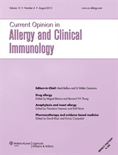
Current Opinion in Allergy and Clinical Immunology
Exploring the forefront of allergy and immunology research.Current Opinion in Allergy and Clinical Immunology, published by Lippincott Williams & Wilkins, is a pivotal journal that serves as a key resource for professionals in the fields of immunology and allergy. With an ISSN of 1528-4050 and an E-ISSN of 1473-6322, this journal presents cutting-edge reviews of the latest research findings, methodologies, and therapeutic approaches in the management of allergic and immunological disorders. With a Q3 category ranking in both Immunology and Allergy for 2023, and a Scopus rank of #103 in Immunology and Allergy, it reflects a solid position within the scientific community. Operating in the highly dynamic fields of immunology and clinical practice since its inception in 2001, the journal aims to harmonize emerging research trends with clinical applications to enhance patient outcomes. Although it does not currently offer Open Access options, the journal's substantial impact factor attests to its significance as a scholarly resource. By disseminating high-quality reviews and expert opinions, Current Opinion in Allergy and Clinical Immunology continues to foster knowledge advancement and professional development among researchers, practitioners, and students alike.
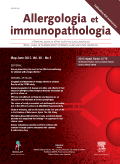
ALLERGOLOGIA ET IMMUNOPATHOLOGIA
Innovating Understanding of Allergic Responses and Immune MechanismsALLERGOLOGIA ET IMMUNOPATHOLOGIA is a distinguished academic journal dedicated to the field of immunology and allergy, published by CODON PUBLICATIONS, based in Singapore. With its ISSN 0301-0546 and E-ISSN 1578-1267, this journal aims to provide an open platform for researchers and practitioners to share their findings, emphasizing topics related to immunopathology and respiratory health. Covering a broad scope from 1973 to 2024, it currently holds a notable position in several category quartiles, including Q3 in Immunology and Allergy, and Q3 in Pulmonary and Respiratory Medicine as of 2023. Despite the absence of an open access option, the journal maintains an essential role in disseminating pivotal research, reflected in its Scopus rankings that position it within the core of its discipline. With an impact factor acknowledging the significance of its contributions, ALLERGOLOGIA ET IMMUNOPATHOLOGIA continues to be a vital resource for ongoing education and advancement in immunological and allergic research.
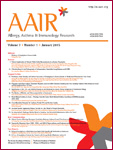
Allergy Asthma & Immunology Research
Exploring breakthroughs in respiratory and immune health.Allergy Asthma & Immunology Research, published by the Korean Academy of Asthma Allergy & Clinical Immunology, is a leading journal dedicated to advancing the fields of immunology, allergy, and respiratory medicine. With an ISSN of 2092-7355 and an E-ISSN of 2092-7363, this esteemed publication has been a cornerstone for researchers and practitioners since its inception in 2009 and continues to disseminate critical findings through till 2024. The journal is ranked in the Q3 category in Immunology and the Q2 category in Immunology and Allergy as well as Pulmonary and Respiratory Medicine, illustrating its impact in these vital fields. With a solid Scopus ranking in multiple sub-disciplines, the journal not only contributes to the scientific discourse but also promotes innovative research and clinical practices. Although currently operating without an open access model, the journal remains highly regarded for its thorough peer-review process and commitment to academic excellence, making it an essential resource for professionals, researchers, and students passionate about advancing knowledge in allergy, asthma, and immunology.